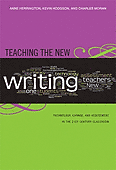 Teaching the New Writing is a compendium of teacher anecdotes, lessons, and insights on what writing instruction looks like in the 21st century classroom. Edited by UMass professors Anne Herrington and Charles Moran, and sixth grade teacher and blogger Kevin Hodgson, the book offers educators of all levels an opportunity to learn from colleagues as they go about bringing 21st century skills into their classroom.
Teaching the New Writing is a compendium of teacher anecdotes, lessons, and insights on what writing instruction looks like in the 21st century classroom. Edited by UMass professors Anne Herrington and Charles Moran, and sixth grade teacher and blogger Kevin Hodgson, the book offers educators of all levels an opportunity to learn from colleagues as they go about bringing 21st century skills into their classroom.Included in the book is an index of technology terms ranging from multimodal composition and vodcasting to digital storytelling and weblogs. Seventeen teachers representing a full range of grades and classes across the education landscape contributed to the book, which features a variety of student work to go alongside lesson plan notes and reflections.
The book is divided into three sections. The first spans the elementary and middle school years, the second focuses on high school, and the final chapter extends to college. Given this range, Teaching the New Writing is apt for a variety of audiences, including classroom teachers, parents, administrators, curriculum coordinators, and pre-service teachers looking to gain a holistic glimpse of writing instruction in the 21st century.
Some of the choice chapters include Chapter 4: Digital Picture Books – From Flatland to Multimedia, Chapter 5: Be a Blogger – Social Networking in the Classroom, Chapter 6: Poetry Fusion – Integrating Video, Verbal, and Audio Texts, and Chapter 12: Technology, Change, and Assessment – What We Have Learned.
One of the core concepts of the book is that we need to rethink our definition of writing. In fact, we should replace it with the word “composing,” and consider composition as the creation of “texts that might include words, images, sounds, and hyperlinks that connect any and all of the above to other words, images, sounds, and hyperlinks” (199).
As far as integrating technology into the classroom, the authors recommend patience, as it will take time for new technologies to intertwine themselves with curriculum. The authors warn that business-as-usual professional development will not work.
“The usual kind of staff development – the one-shot training workshop mandated by the principal or superintendent – will not produce the desired effect, or perhaps any effect at all” (203). Until that model changes, teachers will bring technology into their classrooms gradually, over time, and at different rates. Membership in professional organizations focused on technology integration and attendance at regional and national workshops will be vital to providing teachers with the training necessary to bring their pedagogy to the 21st century.
3 comments:
Thanks for the kind words on the book! Our hope is that it does provide educators some reflective space to examine the teaching of writing/composing during this time of digital change.
Kevin
You're welcome Kevin. I think its format is conducive to that type of reflection. I am looking forward to creating more multimedia, multimodal assignments to better engage my students.
Thanks again for your efforts with the book!
I'm wondering how this sort of thing will be implemented by the new teaching force that is coming in who have been raised with the internet as a part of daily life. I'm in the middle of my certification program and went to High School in the late 90's as the internet was just picking up steam, and finished college in 2004. For me, technology is second nature, but for these kids who are in HS now, it's part of who they are as a person. I'm eager to learn from my students as we explore the frontiers of what text will become in the 21st century.
Post a Comment